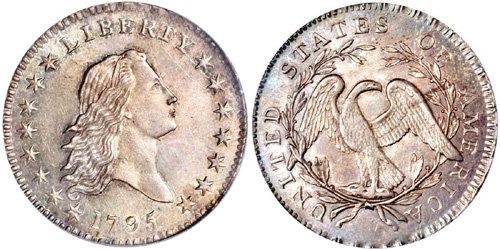Guide to U.S. Flowing Hair Half Dollars
The half dollar was one of the original denominations authorized under the Coinage Act of 1792. The Flowing Hair Half Dollar would represent the first type for the denomination and is counted among the first silver coins struck at the Philadelphia Mint. The same design would be used across the half dime, half dollar, and silver dollar, each representing desirable examples of this historic design which circulated within the early United States. The half dollar series would be issued for only two years from 1794 to 1795 and survivors are scarce, particularly for the lower mintage first year of issue.

1795 Flowing Hair Half Dollar
Obverse Design
The Flowing Hair Half Dollar was designed by Robert Scot. The obverse features the head of Liberty, facing right. Her hair is flowing back, as if in a gentle breeze, with no ornamentation or decoration. The inscription LIBERTY appears above with the date below. There are fifteen stars, positioned eight to the left and seven to the right, representing the number of states in the Union at the time.
Reverse Design
The reverse design carries the image of a bald eagle perched on a cloud with its wings spread. The eagle is enclosed by a wreath, slightly open at the top and bound by a ribbon at the bottom. The inscription UNITED STATES OF AMERICA appears surrounding, starting to the left of the wreath near the bottom and ending on the opposite side. The denomination does not appear on the obverse or reverse of the coin, but rather on the edge, which carries the lettering FIFTY CENTS OR HALF A DOLLAR with small decorations between the words.
As every die for the series was handmade, many different varieties exist. The placement of the stars, date, eagle, and lettering are all used for the purposes of identification. Alongside later half dollar series, this type is often collected by die variety, with premiums attached to the scarcest varieties.

